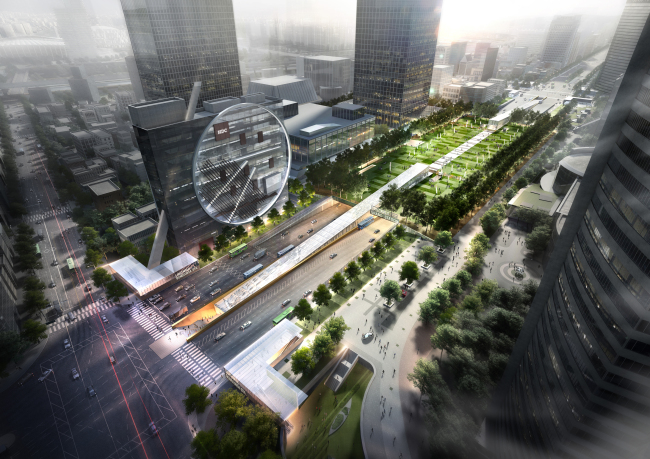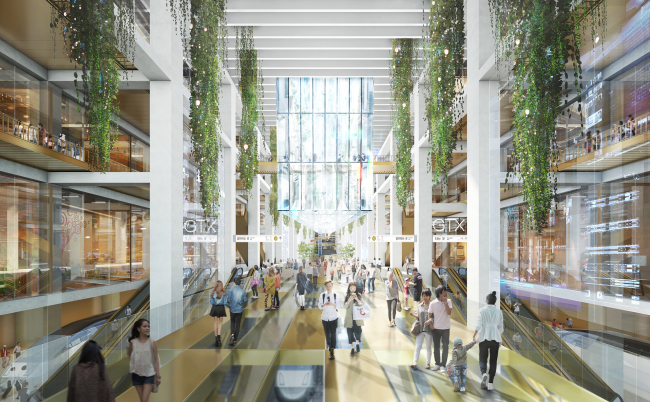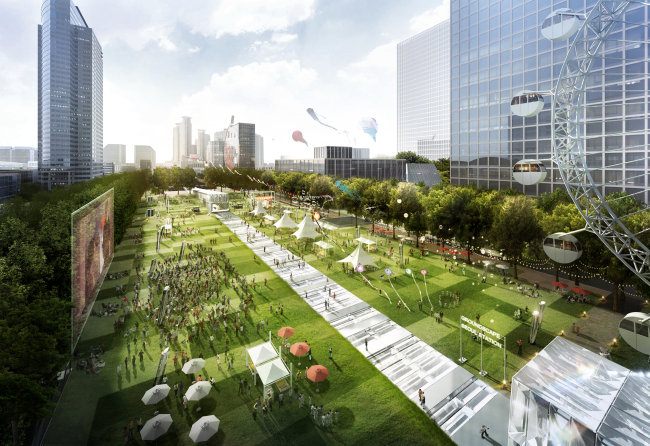The Seoul Metropolitan Government on Monday unveiled a 1.3 trillion won ($1.15 billion) project to build a mammoth underground public transit terminal in Gangnam by 2023 to alleviate road traffic in Seoul’s most congested area.

An artist’s rending of the mammoth underground facility to be built in Gangnam. Seoul Metropolitan Government.
Spanning 160,000 square meters of space across six basement floors, the Yeongdong-daero transit terminal is to be the single largest multifunctional underground complex to be built in the country, the city government said.
“A global consortium led by French architect Dominique Perrault has been selected for the complex’s design,” the Seoul Metropolitan Government announced Monday. Perrault is an architect known here for his work at Ewha Womans University -- the Ewha Campus Complex building.
Perrault’s “Light Walk” project was selected for its “compatibility to nearby districts and ability to digest massive traffic,” city officials explained.
Construction is to begin in 2019 and end in 2023.
Located between Samsung Station on Subway Line No. 2 and Bongeunsa Station on Line No. 9, the underground complex is envisioned to be a multifunctional, cultural and retail space while serving as a major transport hub in the southern part of the capital.
On the upper two levels of the complex, there will be an exhibition hall, a museum, a library and a shopping mall. The levels from the third underground floor down will be used as bus, subway, train transit and transfer centers and parking lots for tour buses.

An artist’s rending of the mammoth underground facility to be built in Gangnam. Seoul Metropolitan Government.
The complex will connect Subway Lines No. 2 and 9 with a direct transfer passageway, and offer a junction of five train lines including the high-speed KTX and bus stops.
The city expects at least 600,000 transit passengers will visit the underground terminal every day, nearly double the number at Seoul Station. Over 180,000 people are expected to take buses here, following the 2023 opening of a bus-only lane in the area.
Yeongdong-daero’s 480-meter sector of road will go underground and the surface area will be created into a 30,000-square-meter public plaza, which is double the size of Seoul Square in front of the City Hall building in Jung-gu.

An artist’s rending of the mammoth underground facility to be built in Gangnam. Seoul Metropolitan Government.
On the surface area between the Coex shopping mall and Hyundai’s proposed new headquarters, Seoul will create an urban park-themed plaza, touted as a rival to New York’s Central Park and London’s Hyde Park.
Solar-powered lamps will be installed by the 560 meter-long boulevard surrounding the plaza and light will come in all day through a specially designed skylight, all the way down to the underground floors.
Seoul City also plans to use this spot as the Korean version of Time Square, as a zone outside Coex was allowed by the Interior Ministry last year for the first time to freely install outdoor digital screens and billboards without any restrictions on types or sizes. The size, type and location of outdoor ads had been strictly restricted prior.
“We will continue to develop this area and complete the underground complex construction successfully so many citizens can visit and commute easily,” said Chung Su-yong, head of the Seoul City’s urban space development bureau.
By Kim Da-sol (
ddd@heraldcorp.com)



![[AtoZ into Korean mind] Humor in Korea: Navigating the line between what's funny and not](http://res.heraldm.com/phpwas/restmb_idxmake.php?idx=645&simg=/content/image/2024/04/22/20240422050642_0.jpg&u=)
![[Exclusive] Korean military set to ban iPhones over 'security' concerns](http://res.heraldm.com/phpwas/restmb_idxmake.php?idx=645&simg=/content/image/2024/04/23/20240423050599_0.jpg&u=20240423183955)



![[Graphic News] 77% of young Koreans still financially dependent](http://res.heraldm.com/phpwas/restmb_idxmake.php?idx=645&simg=/content/image/2024/04/22/20240422050762_0.gif&u=)